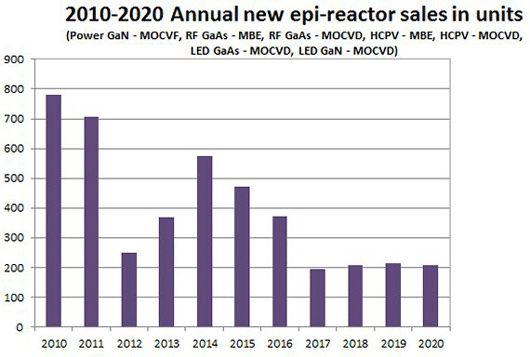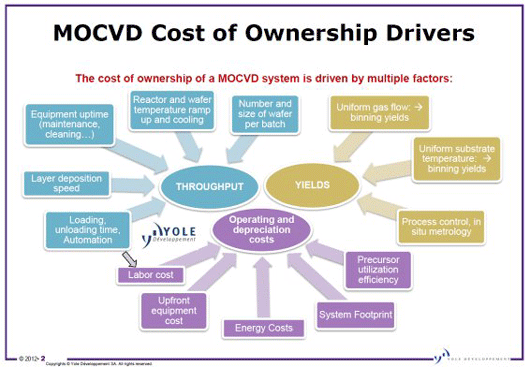- News
11 April 2012
III-V epi substrate & tool market a $6.1bn opportunity over 2012-2020
The combined revenue opportunity for molecular beam epitaxy (MBE) and metal-organic chemical vapour deposition (MOCVD) tools is estimated to be US$6.1bn for 2012-2020, according to market research firm Yole Développement in its report ‘III-V Epitaxy Substrates & Equipment Market’.
LEDs represent by far the single largest application for MOCVD. In 2010 and 2011, the MOCVD market experienced the largest investment cycle in its history, driven by a combination of demand for LED-backlit LCD TVs; subsidies by the Chinese central and local governments; and anticipation of the general lighting market.

This has created significant overcapacity in the market that could take 12-18 months to absorb, says Yole. The next investment cycle - driven by lighting applications and expected to start in 2013 - will be more limited than the previous cycle due to improvements in equipment throughput and yields, the firm notes. Following this cycle, further cost of ownership (COO) improvements offered by the next generation of MOCVD reactors should justify the replacement of two-generation-old reactors installed during the 2010-2011 boom and drive a last small equipment cycle in the second half of the decade, Yole forecasts. By then, power GaN devices will also represent a substantial upside for MOCVD reactor makers.
For MBE, the applications covered in the report represent less than 40% of the total equipment market opportunity. Overall MBE use is heavily driven by R&D systems (over 50% of the total market) and laser applications (telecom, industrial, medical, research), which are not covered in the report.
For the applications covered, the MBE market will be driven essentially by the continuous growth in the cell-phone and wireless applications that make heavy use of GaAs-based RF components. Emerging applications such as smart grid and the trend toward increasing connectivity and ‘intelligence’ incorporated in many consumer products will provide further opportunities, Yole says. However, alternative technologies - silicon CMOS, LDMOS, silicon-on-sapphire (SoS), high-resistivity (HR) silicon-on-insulator (SOI) etc - represent a potential threat and could capture a share of the GaAs RF market and reduce the opportunity for MBE. In addition, MOCVD is making progress in manufacturing of high-electron-mobility transistors (HEMTs). However, high-concentration photovoltaics (HCPV) could provide a small potential upside for MBE reactor makers, reckons Yole.
MOCVD and MBE equipment markets
The MOCVD and MBE equipment markets are duopolies, but many emerging players could change the landscape.
Aixtron and Veeco dominate MOCVD, together representing 96% of the market in 2011. Production MOCVD reactors are complex systems, notes Yole. Their design and optimization require expertise in multiple fields, including flow dynamics, thermodynamics, chemistry, and mechanical and electrical engineering, so the technical barriers to entry are fairly high. More than 15 emerging players have been identified, but so far they have been struggling to capture any sizeable market share. However, pressure is mounting, and established MOCVD reactor makers will need to maintain that technology gap to keep emerging competitors at bay, reckons Yole. The main battlefield is that of total cost of ownership. Established MOCVD makers all have technology roadmaps to enable COO reduction of 3-4x in the next five years through a combination of improved yields, throughputs and precursor utilization efficiency.

For MBE, Riber and Veeco are the only two players offering large-capacity/large-throughput MBE production tools for volume manufacturing. Yole expects that they will maintain this dominant position. However, there are about 10 other MBE manufacturers offering R&D or pilot-production systems (e.g. DCA, SVT, Eiko etc) that also have a strong presence on the general MBE market.
Potential overcapacity in MO precursor supply
The metal-organic (MO) precursor market will also be driven essentially by LED applications. However, MOCVD reactor technology improvements (e.g. yield, consumption, wafer size etc) will lower the amount of trimethyl-gallium (TMGa) and trimethyl-indium (TMIn) needed per cm² of epiwafer.
The metal-organic shortage of 2010 ended in mid-2011 due to aggressive capacity expansion by leading suppliers, notes Yole. Further capacity expansion plans from established and emerging suppliers could come online within the next three years. If executed as announced, Yole expects significant oversupply, starting from 2012, that could continue through 2016 and beyond. This situation could put pressure on prices. Further MO synthesis technology improvements could provide opportunities for cost reduction. However, the usually volatile prices of raw indium and gallium also have a significant impact on cost, comments the market research firm.
